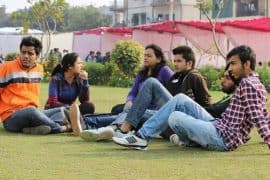In the second part of the ‘DU Mandate’ analysis series, DU Beat examines the opinions of the students regarding the opposition – strengths, weaknesses, leaders and more.
The opposition parties have tried coming together using various permutations and combinations. The Samajwadi Party (SP) and the Bahujan Samaj Party (BSP) have formed an alliance along with the Rashtriya Lok Dal (RLD) to contest the crucial UP polls. Other leaders like Mamata Banerjee, Chandrababu Naidu and H.D. Kumaraswamy, among others, have shared the political stage and given the call to “save democracy”. There seems to be an understanding within the opposition parties that defeating the Bharatiya Janata Party (BJP) won’t be easy without some form of an alliance.
The BJP has targeted the coming together of parties who have previously been hostile towards each other and has questioned the “mahamilawat” (great adulteration) for having no clear indication of a possible prime ministerial candidate.

The narrative of the BJP seems to be resonating with the people. On a scale of 1 to 5, corresponding to the degree of harm, 29.6 percent respondents were of the view that lack of a single prime ministerial candidate from the opposition will do average harm to them, while an almost equal percentage (29.3) said the harm would be of a “fairly high degree”.
Perhaps this idea of a single face being a crucial factor for winnability could have been tempered by a coherent agenda, which could have been seen as a major selling point. However, as per the survey, when asked to select three biggest strengths of the opposition, ‘visionary agenda and programme’ drew the second lowest percentage of votes (12.3 per cent) (This was before launch of the Congress’ manifesto). The biggest strength was considered to be ‘consolidation of non-NDA votes’ with 61.19 per cent votes. ‘Dissatisfaction with the current government’ was voted by 49.3 percent respondents as one of the three biggest strengths, while ‘strong voter bases of individual parties’ stood third. Hence, while the opposition may not have been able to offer a constructive alternate agenda, the government’s disappointing performance could make people turn to it, especially because of the popularity of the regional parties. However, with the recent release of the Congress manifesto, a largely welfare-based document, this shortcoming might be mitigated to an extent.
A similar sentiment was seen in the results for the biggest weaknesses of the opposition. ‘Incapable leaders/unclear leadership’ drew 54.7 percent votes while ‘lack of a strong agenda and programme’ and ‘possibility of forming an “unstable” government’ were selected among the three biggest weaknesses by 51 percent and 44.8 percent respondents.

One issue perhaps lying at the root of these alliance complications was the nature of the coalitions. Since each party would try to cater to its own interest, it won’t be willing to ally with every party everywhere. Hence, a single nation-wide coalition hasn’t come about.
The survey result on this question illustrates this complexity. While 35.2 percent respondents believed multiple state-wise alliances would be better than a single national coalition (29.1 per cent), the supporters of the latter aren’t few either. More interestingly, the ‘can’t say’ option, in fact, drew the maximum vote share of 35.7 percent – indicating a general lack of consensus on the matter.

When asked to select a maximum of three leading faces of the opposition, 78.1 percent selected Rahul Gandhi, while Mamata Banerjee pulled in 52.7 percent. Akhilesh Yadav stood third with 38.2 percent respondents selecting him as one of the three leading faces of the opposition. Some respondents even came up with some creative responses.

Another question asked the respondents to rate the opposition parties and leaders on a scale of 1 to 5, the latter being the highest. Like the rating for the government, the opposition too peaked at a rating of 3, with 30.5 percent votes. A 2-point rating was nearly neck to neck with 29.8 percent votes. However, the contrast between the ratings for the opposition and the government seemed to be on the extremes. While the government had been rated 1 and 5 by 14.3 and 13.3 percent voters respectively, the opposition drew a higher percentage (24.1) of votes at the lowest extreme; only 4.4 percent respondents gave it a 5-point rating.
In a nutshell, 84.4 percent voters gave the opposition a ‘very low’ to ‘average’ rating. In this same range, the government drew 62.1 percent votes. Conversely, 65 percent respondents had given the government a rating of 3 or more, that is, ‘average’ to ‘very good’; the opposition got 46 percent cumulative votes in the same categories.
Conclusion
The government with its largely mediocre performance, some major detrimental decisions and failures resulting in deteriorating conditions in various spheres, still seems to be slightly more popular than the opposition. The narrative about the opposition as comprising “corrupt” and “opportunist” parties that could form an “unstable” government if in power, as publicized by the BJP and its allies, seems to be resonating with the people. The loss of credibility that the opposition parties have suffered since before the 2014 elections and after, despite some state election victories, perhaps makes them a worse option in the eyes of people. So, even if voters are disappointed with the current government, some of them might still lean towards voting it back to power due to a perceived lack of alternatives.
Where the opposition can get its game right, is by forming strong regional alliances to challenge the BJP. Consolidating non-NDA votes can happen by tapping into the strong voter bases of individual parties. Breakthroughs in states where these parties are powerful can help sway the election results at the national level.
Image credits –
(Feature image) HuffPost India
Graphs – ‘DU Mandate’ by DU Beat
Prateek Pankaj
[email protected]




Comments are closed.